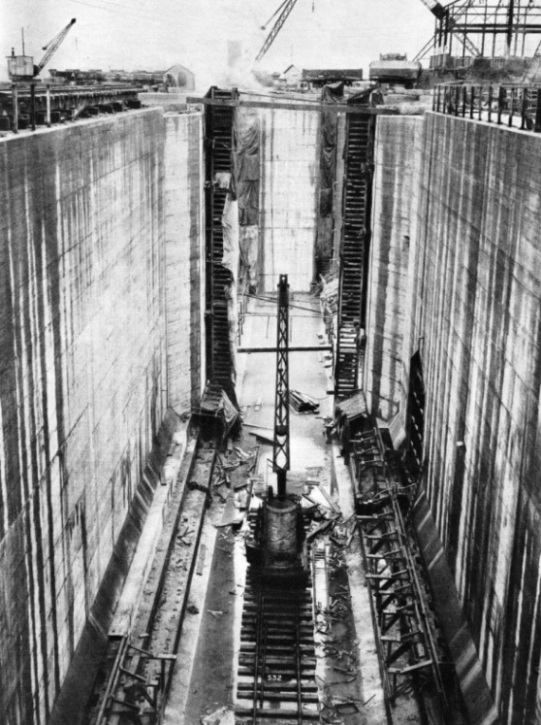

© Wonders of World Engineering 2014-




Part 18
Part 18 of Wonders of World Engineering was published on Tuesday 29th June 1937, price 7d.
Part 18 includes a photogravure supplement showing the construction of the World’s Largest Graving Dock. It illustrates the article on this subject, describing the building of the King George V Graving Dock.
The Cover
The cover this week shows an aeroplane engine being prepared for a wind-tunnel test at the Royal Aircraft Establishment at Farnborough, Hants. The tunnel is equipped with a 30-feet fan and is built of steel and reinforced concrete.”
This cover was later used as the colour plate in part 21.
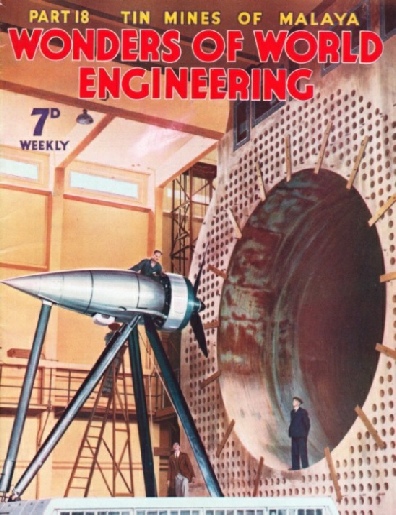
Contents of Part 18
Taming the Euphrates (Part 2)
This construction of the Hindiya Barrage. The article is concluded from part 17 and is the sixth article in the series Triumphs of Irrigation.
GWR 4-6-0 Express Locomotive
THE Great Western Railway has relied for a long period on the single-expansion 4-6-0 type of locomotive as most suitable for the haulage of its express trains. This policy is the fruit of careful experiments with simple and compound engines having various wheel arrangements.
Of the four-cylinder 4-6-0s the most powerful are those of the King class - so called because the engines are named after kings. A typical King is No. 6028, King George VI, which is described in this article.
Subterranean London
Below the streets of London is an amazingly complex system of tunnels which carry thousands of miles of electric cables, gas mains and the like, in addition to the underground rivers which drain the huge area. Of all these subterranean services in London, or in any great city, perhaps he most important are the water supply and the sewerage systems. This chapter describes how the authorities deal with the important and difficult problem of draining such a city as London. This is the fourth article in the series Below the Surface.
World’s Largest Graving Dock
An enormous feat of engineering was involved by the building of the largest graving dock in the world, at Southampton on a site reclaimed from the sea. Named the King George V Dock, it is large enough to accommodate a vessel of 100,000 tons. One of the most important assets of a seaport is a graving dock which can accommodate the large vessels that call at that port. The Queen Mary, which sails regularly from Southampton, has a gross tonnage of 80,773, so that Southampton’s great dock will be able to accommodate vessels considerably larger than the Queen Mary if and when they should be built. This chapter describes the building of the huge graving dock.
World’s Largest Graving Dock (photogravure supplement)
Contents of Part 18 (continued)
Tin Mines of Malaya
This chapter describes the tin mines of Malaya. A great deal of ore is obtained by the use of mammoth dredges, of which the majority are operated by self-contained steam plants. Another form of mining tin, popular with Chinese miners, is known as gravel pump mining. This method resembles the hydraulicking used for obtaining gold in California. Large excavations, too, are made by open cast mining in which rails are laid and mechanical excavators load the trucks with ore. The ore is treated in Malayan mills and refineries. All these processes are described in this chapter.
Isambard Kingdom Brunel
Born in 1806, lsambard Kingdom Brunel was the son of Sir Marc lsambard Brunel, a famous engineer. The younger Brunel made history by his work for the Great Western Railway and by his later work in popularizing screw propulsion for ships. This is the seventh article in the series on Makers of Engineering History.
The Road to Hudson Bay (Part 1)
Over muskeg and swamp for 500 miles a railroad was built from the prairies of Manitoba to Churchill, on the shores of Hudson Bay, where a grain elevator and other port facilities were provided as a new outlet for the produce of Western Canada. Of recent years the building of the Hudson Bay Railway and the establishment of the port of Churchill on the shores of Hudson Bay have aroused considerable interest. The new outlet for the wealth of the prairie lands of Manitoba has justified the expenditure of £6,000,000. This chapter describes the building of this pioneer railroad. The chapter is concluded in part 19. It is the sixth article in the
series Railway Engineers at Work.
World’s Largest
Graving Dock:
Photogravure Supplement
SHORE END of the King George V Graving Dock during construction. At this end of the dock was set up the special plant which washed the gravel excavated from the dock site and mixed the concrete used for building the floor and walls of the dock.
World’s Largest Graving Dock: The Floor of the Dock
THE FLOOR OF THE DOCK is built of concrete 25 feet thick. This slab of concrete, 200 feet wide and 1,200 feet long, serves the double purpose of supporting the weight of the world’s largest liners and of holding down the pressure of artesian water from underneath. At intervals of 200 feet the walls of the dock are vertical buttresses.
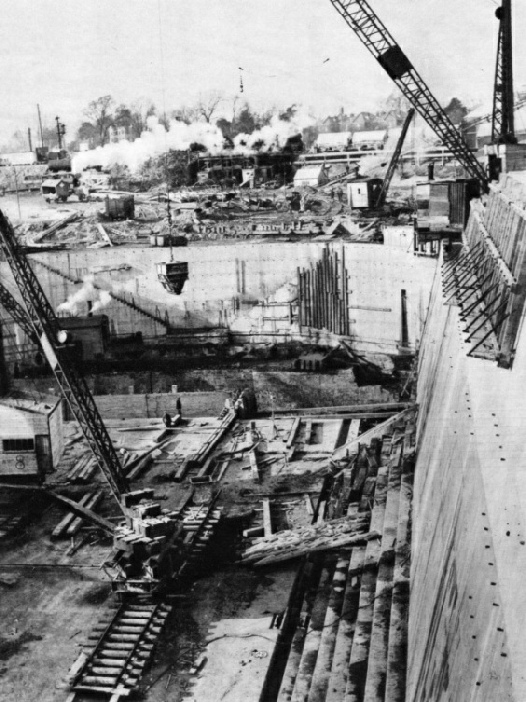
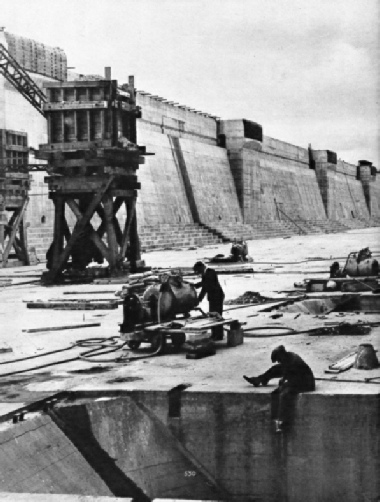
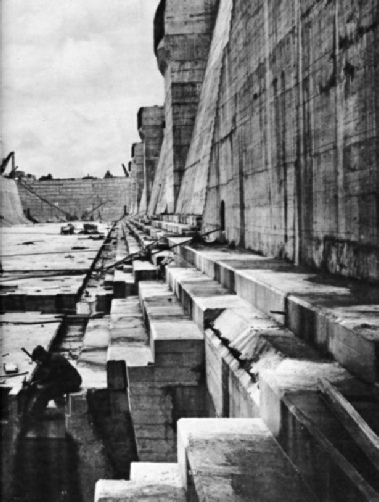
World’s Largest
Graving Dock:
Photogravure Supplement - 3
A MINIATURE DOCK, opening off the entrance to the graving dock, was built to receive the caisson gate when the graving dock entrance is open. The caisson is hauled into this dock, or “camber”, by an electrically-driven winch operating massive steel chains.
